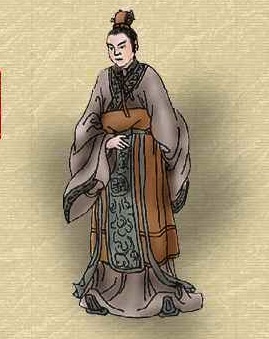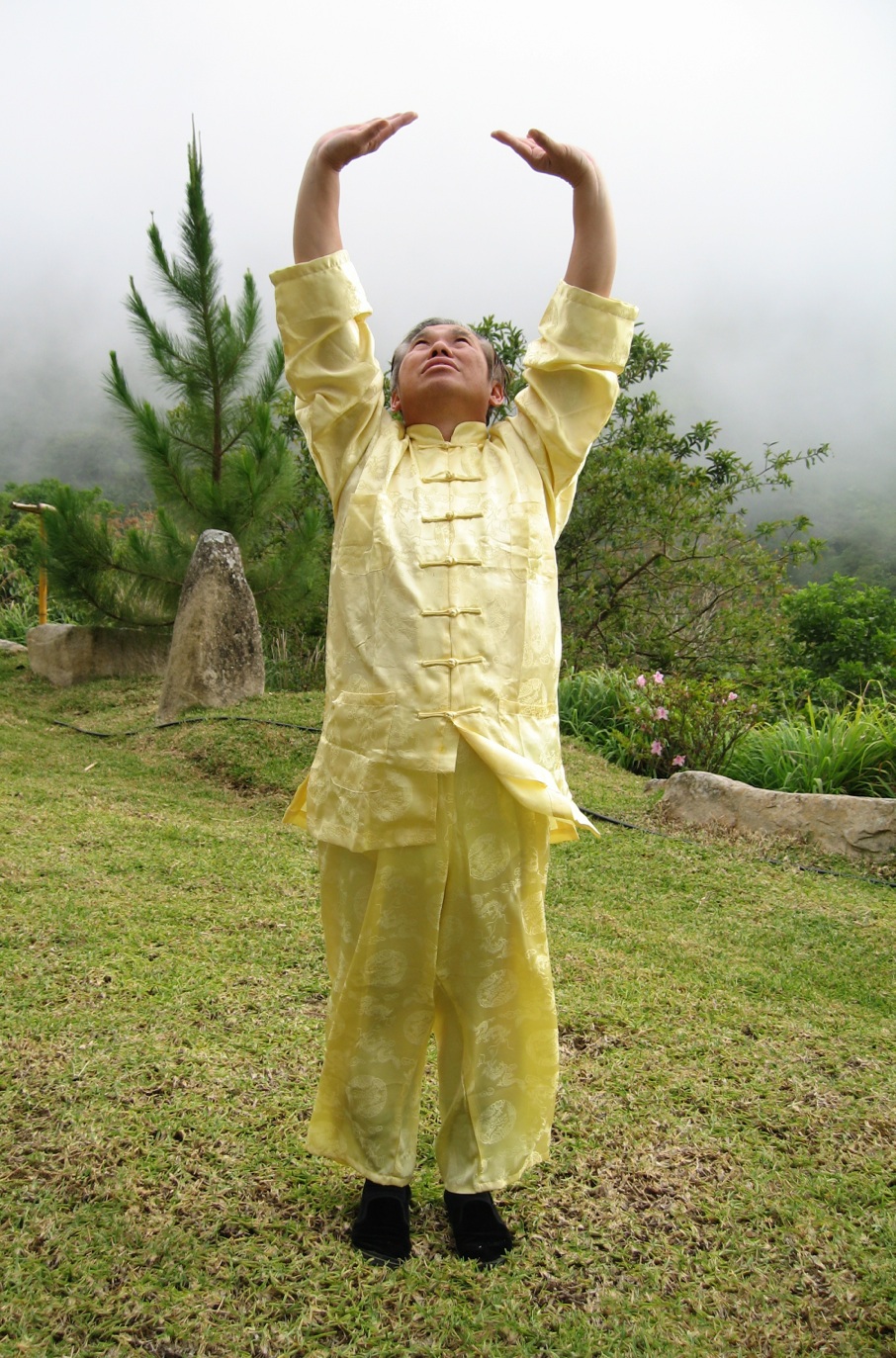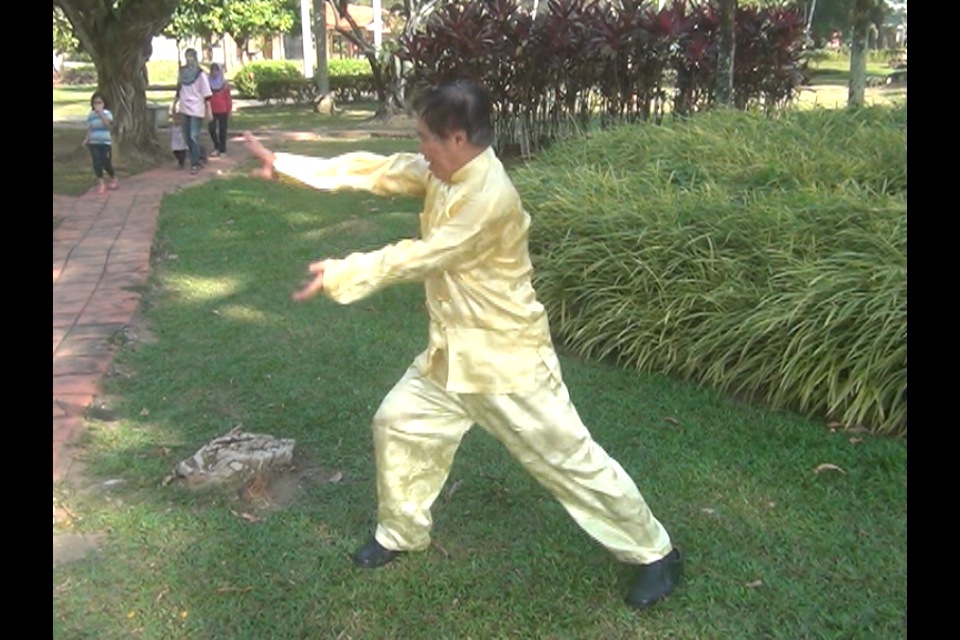SELECTION OF QUESTIONS AND ANSWERS
AUGUST 2014 PART 3

Cao Zhi, the poet who created a poem after walking seven steps
Question 1
Sifu, your instructions are very clear. But why is it that when you give simple instructions like just observing your demonstration and not following your action, some students still follow your action? You must be quite annoyed with them.
— Sifu Fleur Chapman, England
Editorial Note
These questions from Sifu Fleur Chapman were asked during the UK Summer Camp 2013, but because of a long waiting list for the Question-Answer Series, they are only posted now.
Answer
Actually I want to help these students rather than outpouring my annoyance when I highlight this point in my teaching. I want to "shock" them that they may not be as mentally alert as they thought they were. This lesson will be useful to them.
A main reason why some students fail to observe my instruction of just observing my demonstration instead of following it, is due to route learning. If you, for example, show a flash card of each of the numbers from 1 to 10 in quick succession and ask your observers to call the number as the card is shown, when you come to the number 8, instead of showing it you show another number, some of the observers will still call out the number 8.
Similarly as the students were following my demonstration, when I suddenly asked them to observe instead of following the next movement, some of them would still follow the movement.
Question 2
In the 36 Strategies course, you could supply a strategy to a problem supplied by us just after walking seven steps. We were all amazed. How did you do it? How did you come up with a strategy so quickly?
Answer
This demonstration, as a response to one of the participants who implied that participants might not have sufficient time to come out with a strategy, served two useful objectives. It demonstrated that my method worked.
Secondly it inspired participants that they too could use the method rewardingly. They might not be able yet to come out with a strategy in seven seconds I took to walk the seven steps, but they could do so in ten minutes.
The method is as follows. Clear the mind of all thoughts. Define the problem with a clear mind. Once the problem is defined, solutions will appear. Translate the solutions you see in your clear mind as practical actions, not as philosophical issues.

Eighteen Lohan Hands, picture created by Sifu Leonard
Question 3
Why are there seven steps? Is there any significance for the number seven?
Answer
This concept of seven steps a strategy is taken from a story, “Seven Steps a Poem”.
During the Three-Kingdom Period in the 3rd century there was a famous poet called Cao Zhi. His brother, Cao Pi, was the King of Wei. Both were the sons of Cao Cao, the famous general cum prime minister made known to the West in the movie, Red Cliff.
Cao Pi was suspicious of his younger brother, Cao Zhi, and wanted to kill him. He summoned Cao Zhi to court and ordered him to compose a poem in the time to walk seven steps. After walking seven steps, Cao Zhi composed the following poem:
-
Beanstalks are used to boil beans
The beans are crying in pain
Both are issued from the same roots
Why kill each other in vain
Cao Pi was touched by the poem and spared his brother’s life.
Question 4
You mentioned about defining the problem and having practical action instead of theoretical debate. This teaching is very important. Can you please elaborate?
Answer
Many people are tormented by problems. They could not find solutions to their problems because often they do not really know what the problems are, or they philosophize on their problems instead of taking practical actions to solve them.
Suppose an instructor has a problem of getting students to start a chi kung class. He always thinks that he has a problem of starting a class, and he often philosophize on how chi kung training will benefit many people, and how his students can overcome illness and be healthy and have vitality.
He can carry on thinking about his problem for years but he will never solve it. What should he do. He should do three things:
1. He should clear his mind of all thoughts and define his problem.
2. He should list the practical actions he should do to solve the problem.
3. He should act on the practical actions as soon as possible and as best as he can within his resources.
For the first task, many instructors think of their problems as follows:
1. Chi kung can heal all kinds of illness.
2. My students will overcome their illness, and have vitality.
3. How often should I hold classes?
4. Where will the classes be?
These instructors will be unsuccessful as they have not defined the problem. A successful instructor will define his problem as follows:
How do I get students to start my chi kung class?
By asking the right question, he will get some possible solutions, like as follows:
1. Prepare brochures for the public.
2. Advertise in newspapers and magazines.
3. Talk to friends.
4. Organize seminars.
5. Send publicity material to clubs, organizations and schools.
For the third task, he will act on those actions that are within his means. As advertising in newspapers and magazines may be expensive, he may leave this out. If he carries out the viable actions instead of just thinking over them, even if he is only mediocre in his attempt, he can get enough students to start a class.
Unsuccessful instructors, on the other hand, will intellectualize on the problem instead of carrying out actions. They may ask questions as follows:
1. How do I let the public know about my chi kung class? .
2. Should my fee be 50 pounds or 500 pounds or anywhere in between? .
3. What kind of students will I have? .
4. Will my students overcome their illness and have good health?
They will just ask these questions and may think of good answers, but they never take any action on them. For example, they may have good theoretical answers on how to let the public know about their chi kung classes, but they never carry out any action. They may think of their problem for years but will never overcome it. Their failure is due to three reasons:
1. They did not define their problem clearly. .
2. They did not list practical actions to be taken. .
3. They merely philosophize on their problem.
Solving problems calls for practical action. No amount of philosophizing, no matter how beautiful the philosophy may be, can solve it.

Lifting the Sky
Question 5
What is the significance of the order of the 18 Lohan Hands?
— Sifu Jeffrey Segal, Chief Instructor of Australia
Answer
Like in all other chi kung exercises, the Eighteen Lohan Hands are holistic and thematic. Each one of the Eighteen Lohan Hands contribute to good health, vitality and longevity, which are holistic benefits of all chi kung, as well as thematic benefits specific to the exercise.
The following is a brief list of the thematic benefits of each of the Eighteen Lohan Hands. Examining this list will reveal the significance of the order of the Eighteen Lohan Hands. Please note that only the main benefit relevant to the question is shown for each exercise, other benefits are not shown.
1. Lifting the Sky generates an over-all chi flow.
2. Shooting Arrows activates chi flow.
3. Turning Head sends energy down the central nervous system
4. Plucking Stars open meridians of the arms and legs.
5. Punching with Angry Eyes strengthen the heart.
6. Merry-Go-Round operates on organs at the abdomen.
7. Carrying the Moon works on the back of the body.
8. Nourishing Kidneys sends chi down the legs.
9. Three Levels to Ground works on the knees.
10. Dancing Crane works on the legs.
11. Carrying Mountain facilitates waist rotation.
12. Drawing Knife opens the Eight Wondrous Meridians.
13. Presenting Claws sends chi to the fingers.
14. Pushing Mountains facilitates chi flow to arms and legs.
15. Separating Water opens the chest.
16. Big Windmill sends chi to the hands.
17. Rotating Knees makes the legs flexible.
18. Deep Knee Bending sends chi to the toes.
Hence, the Eighteen Lohan Hands start with a general chi flow and activate meridians for subsequent chi flow to specific parts of the body working from the head down the body to the legs. Every part of the body (and mind) is involved.
While the eighteen exercises fulfill the general aims of chi kung in providing good health, vitality and longevity, they also deal with specific health problems related to particular parts of the body.
Having fulfilled the fundamental aims of chi kung in providing good health, vitality and longevity, the eighteen exercises also enhance mental clarity and increase energy for peak performance, and then prepare practitioners for the highest spiritual attainment.
The order the exercise are arranged facilitates these aims and objectives.
Question 6
I felt amazingly good, happy and had a great mood all the time. It was simply amazing. Beside this I start to go in a really deep state of consciousness and to have different experiences like seeing some masters descending from a kind of paradise to talk to me.
Sometimes I saw myself doing chi kung outside of my body in another kind of realm. I even projected myself two times and saw myself in a past life living alone and meditating in some mountains.
When I projected myself there, the man I was saw me and recognized me. He smiled with a kind of expression in his face like telling me "Hey there you are? Somehow it was like me being two persons at the same time. Would you be so kind and comment on that experience? Is it possible to jump through time and space like this and to meet oneself in other life?
In other similar experience I projected myself to the future. I saw myself in a kind of room dressing a white Chinese suit teaching chi kung to a group of people. That was in my present life but in a future time. I was standing there talking but again when my spirit or my mind (I don't know what really was) arrived at the place the "me of the future" saw me and recognized me again. Is something like that possible?
— Davy, Germany
Answer
I am glad of your benefits from our training. Most people may think you have gone crazy, but your experiences are not uncommon amongst some of our students.
It is not easy to tell from an e-mail whether what you have described was true or just your imagination, as you yourself have said. But as two of your sifus, Maxime and Kai, who are amongst our best instructors, have seen you and have endorsed what you have said, as well as you have written sensibly and respectfully to me, and these experiences do occur in our sccool, I would give you the benefit of doubt
Your experiences could be true. It is likely you were a master in your previous lives.
Yes, it is possible to jump through time and space. Some of our Shaolin Wahnam Family members have done that. But do not place too much attention to it. You live in the present.
Seeing the future is also possible. As this will happen in the future in your present, it is easy to test whether it is true. You can use this experience as an inspiration for your training.

Dragon force is trained in the Dragon Strength Set
Question 7
I got also in contact with somebody who introduced himself to me as Wudang master. I had all the time the feeling that he was a very high level medicine doctor.
He told me I should train dragon force as that force was important for real Taijiquan. In order to do so I should for example meditate more to connect my mind with my chi, he told me.
He told me also to train 3 Circle Stand but in Horse Riding stance and to train specially Cloud Hands. He said Cloud Hands was the origin of Wudang Taijiquan and all the art is founded in Cloud Hands, which has to be trained in all possible variations.
Answer
I don’t know about connecting your mind with your chi in your meditation. We are mindful of our chi as well as our physical movements whenever we train as well as in our daily life. It was true that dragon force was the force for Wudang Taijiquan.
Holding the hands like in Three-Circle Stance while performing the Horse-Riding Stance was important in the past. It is a very effective way to train internal force, and is very useful in Taijiquan training.
Yes, I believed Taijiquan originated from Cloud Hands. It was not called Taijiquan at the time when Zhang San Feng developed the art from Shaolin Kungfu. It was called Shaolin Kungfu, and later Wudang Kungfu. Much later it was called Taijiquan.
Question 8
He said that I should search the dragon and until now I am not hundred percent sure what it means. Should I train to develop dragon force?
My Sifu, Sifu Maxime, told me once that no matter what I do it looks like I will become a dragon, considering the way the chi moves my body. It is related to that message?
Sifu Kai recommended me to ask that master who he was if he appears again. So I did it. I guess I got an answer but I am not sure if that was the real answer or just my mind playing with me. I would like that you clarify my doubt if it is possible.
Answer
Dragon force is taught in my Dragon Strength course in December 2014.
Dragon force is also found in many force training methods in our school, like One-Finger Shooting Zen and Double Dragons Emerge from Sea.
Yes, your sifu, Maxime, was accurate in his observation. It is related to the message.
Kai gave you very good advice.
LINKS
Selected Reading
- Benefits of Knowing the 36 Strategies
- A Question of Paradigm
- A Gentle Touch of Dim Mark
- Histoy and Philosophy of 108-Pattern Yang Style Taijiquan
- The Butterfly Knives and their Combat Application
